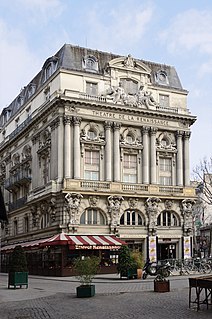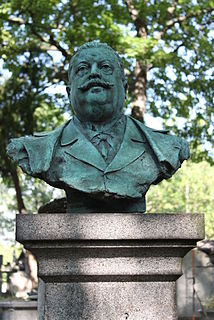

Anne-Elisa Alice Ducasse, was born in Valparaiso (Chile) on May 20, 1841, and died December 4, 1923, in Paris in the 9th arrondissement. [1] She was an opera singer and teacher active in Paris. [2]


Anne-Elisa Alice Ducasse, was born in Valparaiso (Chile) on May 20, 1841, and died December 4, 1923, in Paris in the 9th arrondissement. [1] She was an opera singer and teacher active in Paris. [2]
Alice Ducasse is the daughter of Pierre Édouard Ducasse and Blanche Aline Pelletier.
As a member of the company at the Théâtre Lyrique under Pasdeloup and Vizentini she sang various roles at that theatre, creating Mab in Bizet's La jolie fille de Perth , as well as Nérine in L'irato by Méhul (November 1868), Formosa in En Prison by Guiraud (March 1869), Thérèse in Don Quichotte by Boulanger (May 1869) [2] and Nydia in Le Dernier Jour de Pompéi by Victorin Joncières (September 1869) [3]
Moving over to the Opéra Comique she created Léna in the 1872 premiere of La princesse jaune , and Frasquita in the 1875 premiere of Carmen , as well as singing in the first Opéra Comique performances of works premiered elsewhere: Jacqueline in Le médecin malgré lui in 1872, Stéphano in Roméo et Juliette in 1873, a shepherd in the 1874 revival of Le pardon de Ploërmel , Nicette in the 1871 revival of Le Pré aux clercs (the 1,000th performance), Mirza in the 1876 production of Lalla-Roukh , Rita in the 1877 revival of Zampa (500th performance) and Papagena in the 1879 production of The Magic Flute . [4]
Other roles included Bertrand in the 500th anniversary ('travesty') performance at the Opéra-Comique of Les Rendez-Vous Bourgeois by Isouard in March 1873, Georgette in Le val d'Andorre in October 1875, and Gillotin in Gille et Gillotin in March 1877. In October 1880, Ducasse sang Germaine in the premiere of Monsieur de Floridor at the Opéra-Comique. [5]
After appearing as Marceline in The Marriage of Figaro in May 1882, Ducasse left the stage to take up teaching. [5]
One of her students is the actress Amélie Diéterle.

Ernest Guiraud was an American-born French composer and music teacher. He is best known for writing the traditional orchestral recitatives used for Bizet's opera Carmen and for Offenbach's opera Les contes d'Hoffmann.

The Théâtre de la Ville is one of the two theatres built in the 19th century by Baron Haussmann at Place du Châtelet, Paris, the other being the Théâtre du Châtelet. It is located at 2, place du Châtelet in the 4th arrondissement.

The name Théâtre de la Renaissance has been used successively for three distinct Parisian theatre companies. The first two companies, which were short-lived enterprises in the 19th century, used the Salle Ventadour, now an office building on the Rue Méhul in the 2nd arrondissement.

The Théâtre Lyrique was one of four opera companies performing in Paris during the middle of the 19th century. The company was founded in 1847 as the Opéra-National by the French composer Adolphe Adam and renamed Théâtre Lyrique in 1852. It used four different theatres in succession, the Cirque Olympique, the Théâtre Historique, the Salle du Théâtre-Lyrique, and the Salle de l'Athénée, until it ceased operations in 1872.

Jules Danbé was a French violinist, composer and conductor, mainly of opera.
Louis Michel Adolphe Deloffre was a French violinist and conductor active in London and Paris, who conducted several important operatic premieres in the latter city, particularly by Charles Gounod and Georges Bizet.
Marguerite Chapuy was a French operatic soprano and the daughter of a former dancer at the Opéra. Her short professional career was concentrated on Paris but included appearances in London; she created several roles at the Opéra-Comique.

Marie Cico, was a French singer of opéra-comique and operetta.

Charles-Henri Edmond Duvernoy was a French pianist, baritone and vocal teacher, from a family of musicians.

Félix-Ludger Rossignol, known as Victorin de Joncières, was a French composer and music critic.

Albert Vizentini was a French violinist, composer, conductor and music writer, born in Paris on 9 November 1841, and died there on 21 October 1906. His main centre of activity was the French capital, but he also worked for ten years in Russia and toured in Britain and Ireland.

In 1862 during Haussmann's modernization of Paris, the Théâtre de la Gaîté of the boulevard du Temple was relocated to the rue Papin across from the Square des Arts et Métiers. The new theatre, built in an Italian style to designs of the architects Jacques-Ignace Hittorff and Alphonse Cusin, opened on 3 September.
The Devriès family were operatic singers over three generations, of Dutch descent. They were mainly active in France, Belgium and the USA in the second half of the 19th and the early 20th centuries.

Cécile Mézéray was a French soprano active in France and Belgium in the mid nineteenth century. Born around 1859, she was one of the daughters of the musician Charles Mézeray. Her sisters Caroline and Reine were also professional singers. As well as singing, Cécile also played the harp.

Marie Delna was a French contralto. A major singer in Paris, particularly at the Opéra-Comique, she enjoyed an international career in the 1890s through to the 1910s and left several recordings.

Théâtre de l'Athénée or Salle de l'Athénée was the name of a theatre in the basement of a building built in 1865 by the banker Bischoffsheim at 17 rue Scribe in the 9th arrondissement of Paris. The Athénée was initially small, with a capacity of 760 spectators, but was enlarged to 900 places by the addition of a top gallery in 1867. The interior was decorated by Charles Cambon. The venue was used by a variety of companies, including the Théâtre des Fantaisies-Parisiennes (1869), the Théâtre Lyrique (1871–1872), the Théâtre Scribe (1874–1875), and the Athénée-Comique (1876–1883). It closed permanently in 1883.

Alfred Duru was a 19th-century French playwright and operetta librettist who collaborated on more than 40 librettos for the leading French composers of operetta: Hervé, Offenbach, Lecocq and Audran.
Frédéric Barbier was a 19th-century French composer.

Marie-Thérèse Gauley was a French opera and concert singer who sang leading soprano and mezzo-soprano roles at the Opéra-Comique in Paris as well as in other French cities and abroad. She was also heard in early broadcasts on French radio and made several recordings for Disques Odéon. Amongst the roles she created were The Child in Ravel's opera L'enfant et les sortilèges.

Marguerite-Marie-Sophie Polliart or Poliart, generally known by her stage name Priola, (1849–1876) was a French operatic soprano. She made her début on 6 April 1869 in Paris as The Messenger of Peace in the first French production of Wagner's Rienzi at the Théâtre Lyrique. She enjoyed a successful career at the Opéra-Comique until 1874, performing mainly coloratura soprano roles. There she created several roles, including Princess Elsbeth in Offenbach's Fantasio, Maritana in Massenet's Don César de Bazan, and Javotte in Le Roi l'a dit by Delibes. In 1876, on joining the Opéra de Marseille, she appeared as Philine in Mignon by Ambroise Thomas although she was ill. She was booed throughout the performance, and died three weeks later.